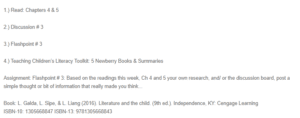Enhancing Literacy – Evaluating Picturebooks and Nonfiction for Student Learning
The most outstanding idea in chapters 4 and 5 of the text “Literature and the Child” was about essential features of picturebooks and nonfiction that make them effective learning materials for students, enhancing their writing and reading skills. The need to consider the quality of the two materials made me think about the best features to consider when recommending a text for students. For picturebooks, the teacher should evaluate the language used to reinforce thoughts. Instructors need to consider how rich the language is to steer learning. Picturebooks’ information should be interesting and expressed in an exciting way to make learning fun (Goga et al., 2021). The artistical work should be appealing and informative to help learners develop meaning and predict the chronological flow of events with fewer word illustrations. Picturebooks should be visually appealing and not inhibit content understanding (Galda et al., 2016). Students prefer interacting with books that connect their feelings, which the text portrays.
Additionally, the dominance of nonfiction in today’s life triggered my thinking on what to consider when determining the best nonfiction for students, which promotes relevant information and supports an effective learning atmosphere. According to Galda et al. (2016), nonfiction should contain high accuracy levels. Nonfiction should also convey facts on specific ideas (Galda et al., 2016). The scope of the text should blend effectively with its audience’s expectations. Professionals and experts should publish the books in the specific area being addressed, with their expertise being well documented. A nonfiction book should be developed and organized logically to avoid misunderstandings when interacting with the text. Goga et al. (2021) add that the texts should have an attractive and reader-friendly design with effective styles and rich language that makes students curious.
References
Galda, L., Liang, L. A., & Cullinan, B. E. (2016). Literature and the child. Cengage Learning.
Goga, N., Iversen, S. H., & Teigland, A. S. (Eds.). (2021). Verbal and visual strategies in nonfiction picturebooks: Theoretical and analytical approaches. Scandinavian University Press.
ORDER A PLAGIARISM-FREE PAPER HERE
We’ll write everything from scratch
Question

Evaluating Picturebooks and Nonfiction for Student Learning
1.) Read: Chapters 4 & 5
2.) Discussion # 3
3.) Flashpoint # 3
4.) Teaching Children’s Literacy Toolkit: 5 Newberry Books & Summaries
Assignment: Flashpoint # 3: Based on the readings this week, Ch 4 and 5 your own research, and/ or the discussion board, post a simple thought or bit of information that really made you think…
Book: L. Galda, L. Sipe, & L. Liang (2016). Literature and the child. (9th ed.). Independence, KY: Cengage Learning
ISBN-10: 1305668847 ISBN-13: 9781305668843


